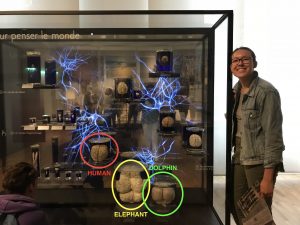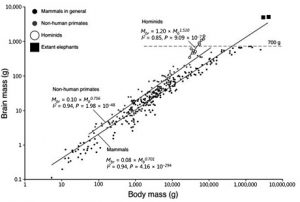Earlier this week, we took a class trip to Musée de l’Homme, which as your rudimentary French might suggest, specializes in all things human. This anthropological museum opened an exhibit just this past March titled, “Néandertal l’Expo,” and covers everything from general Neaderthal knowledge to lesser known facts and findings. Incorporating archeological findings, popular culture, and interactive displays, this exhibition comprehensively covers the misconceptions, controversies, and remaining mystery surrounding Neanderthal life and extinction, and is a must see for any Paris travelers with moderate to extreme interest in anthropological sciences. The rest of the museum includes everything from displays on evolution, human history, science of language, world cultures, gender issues, all the way to Lucy the 3 million-year-old Australopithecus and one of the most prominent fossil findings of all time.
I discovered a small display on the first floor that showcased a variety of preserved mammalian brains. Naturally, as an neuroscience major, I was drawn to the wrinkly, grey blobs floating in jars (Fig. 1). They had on display a human brain, an elephant brain, a dolphin brain, as well as a series of monkey and primate brains. The human brain was actually quite overshadowed by the shear enormity of the elephant and dolphin brains next to it. Brain size and corresponding phenotype has been a long-standing question in neuroscience. Early notions were that brain size was simply relative to body weight. However, more recent work has discovered that while this explains the majority of the trends seen in brain size among mammals, this is not a hard and fast rule. There are a series of exceptions to this ratio and apparent physiological constraints to brain size despite body weight. Furthermore, brain size is not an absolute indicator for cognitive capabilities (Manger, Spocter, & Patzke, 2013).
Generally, increased brain size relative to body weight is an indicator of “intelligence.” Humans, chimpanzees, elephants, and dolphins fall above this trendline among mammals, which is commonly used as an explanation for their high cognitive abilities (Fig. 2). The elephant is a commonly studied brain due to its shear mass, even relative to its body weight. There have also been findings that different species of elephants with similar body masses have different brain masses and encephalization quotients. The brains of cetaceans, i.e. dolphins, whales, etc., are also characteristic for their large size and low neuronal density (Manger et al., 2013). This low neuronal density is also thought to be correlated with corresponding phenotypes. This includes theories of larger dendritic branching, i.e. larger neurons, and greater glia/neuron ratios needed for cognitive abilities such as long-term acquisition of learned behavior (Herculano-Houzel, 2014). These trends and exceptions have helped scientists study the mechanisms of animal behavior and brain function.
Works Cited
Herculano-Houzel, S. (2014). The glia/neuron ratio: How it varies uniformly across brain structures and species and what that means for brain physiology and evolution. Glia, 62(9), 1377-1391. doi:10.1002/glia.22683
Manger, P. R., Spocter, M. A., & Patzke, N. (2013). The Evolutions of Large Brain Size in Mammals: The ‘Over-700-Gram Club Quartet’. Brain, Behavior and Evolution, 82(1), 68-78. doi:10.1159/000352056


